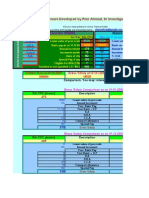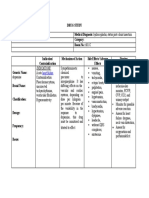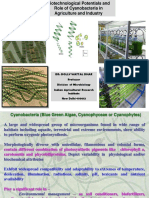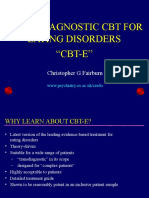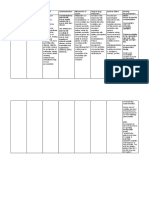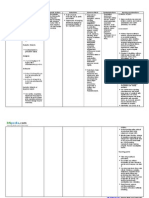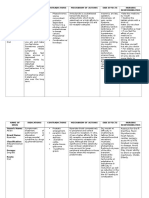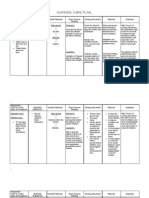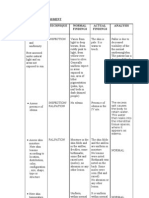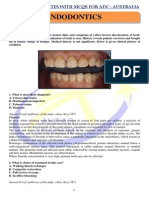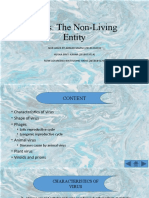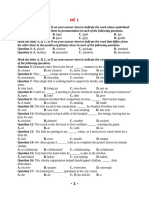Drug Study
Uploaded by
Kate ChavezDrug Study
Uploaded by
Kate ChavezSan Beda College COLLEGE OF NURSING P.O. BOX 4457 1005 MANILA, PHILIPPINES TELEFAX: 735-6011 to 15 Loc.
4131 GENERIC NAME:MIDAZOLAM Route of Administration: IV DRUG MODE OF CLASS ACTION Anxiolytics / Hypnotics & Sedatives / Anticonvul sants Midazolam is a short-acting benzodiazepine. It exerts sedative and hypnotic, muscle relaxant, anxiolytic and anticonvulsant actions. While the probable anxiolytic action might be as a result of the drug's ability to increase glycine inhibitory neurotransmitter level, the hypnotic/anaesthet ic action may be due to the occupation of the benzodiazepine and GABA receptors leading BRAND NAME: Versed Dosage: 1mg/IV ADVERSE DRUG REACTIONS TO INTERACTION WATCH OUT S FOR Physical and Increased CNS psychological depression dependence with alcohol, with withdrawal opioids, symptoms; barbiturates, decreased tidal other sedatives volume and and respiration rate; anaesthetics. apnoea; Increased headache; respiratory hiccup; nausea, depression increased with appetite, opiates, pheno vomiting; cough; barbital, other oversedation; benzodiazepin seizure-like es. Plasma activity concentrations (paediatrics); increased by paradoxical CYP3A4 reactions; inhibitors such kernicterus; as cimetidine, nystagmus; skin erythromycin, rash, pruritus; clarithromycin, reduced diltiazem, vera
INDICATIONS/ CONTRA INDICATIONS INDICATION: HIV protease inhibitors, nefazod one, sertraline, gra pefruit juice, fluoxetine, er ythromycin, diltiaz em, clarithromycin inhibit the metabolism of midazolam, leading to a prolonged action. St John's wort, rifapentine, ri fampin, rifabutin, p henytoin enhance the metabolism of midazolam leading to a reduced action. Sedating antidepressants, antiepileptic drugs such as phenobarbital,
NURSING HEALTH CONSIDERAT TEACHINGS IONS Assess level of sedation and level of consciousness throughout and for 2-6 hr following administration . Monitor BP, pulse and respiration continuously during IV administration . Oxygen and resuscitative equipment should be immediately available. If overdose Do not drive or engage in potentially hazardous activities until response to drug is known. You may feel drowsy, weak, or tired for 12 d after drug has been given. Be prepared for amnesia to prevent an upsetting postoperative period. Review written instructions to assure future
to membrane hyperpolarisation and neuronal inhibition, and further interfering with the re-uptake of GABA at the synapses. Absorption: Rapid ly absorbed (any route); peak plasma concentrations after 20-60 min (depending on route). Distribution: Cros ses the placenta; enters breast milk. Protein-binding: 96% Metabolism: Exte nsively hepatic via CYP3A4 isoenzyme; converted to hydroxymethylmid azolam. Excretion: Urine (as glucuronide conjugates); 2 hr (elimination half-
phenytoin and carbamazepin e, sedative antihista mines, opiates, anti psychotics and alco hol enhance the sedative effects of midazolam. Midazo lam is metabolized almost completely by cytochrome P450-3A4. Atorvast atin administration along with midazolam results in a reduced elimination rate of midazolam. St John's wort decreases the blood levels of midazolam. Grapef ruit juice reduces intestinal 3A4 and results in less metabolism and higher plasma concentrations CONTRAINDICATIO N: Acute narrow-angle glaucoma; coma or patients in shock;
alertness, confusion, euphoria, hallucinations, fatigue, dizziness, ataxia, postoperative sedation, anterograde amnesia; jaundice; cardiac arrest, heart rate changes, thrombosis; anaphylaxis; laryngospasm, bronchospasm. Potentially Fatal: Respirato ry depression, respiratory arrest; hypotension.
pamil, ketocon azole and itrac onazole, antiretroviral agents, quinup ristin with dalfo pristin. Midazolam concentration decreased by phenytoin, c arbamazepine, phenobarbital, rifampicin. Hal othane, thiopental requirements may be reduced during concurrent use.
occurs, monitor pulse, respiration , and BP continuously. Maintain patent airway and assist ventilation as needed. If hypotension occurs, treatment includes IV fluids, repositioning and vasopressors. The effects of midazolam can be reversed with flumazenil (Romazicon).
understanding and compliance. Patient teaching during amnestic period may not be remembered. Even if dose is small and depth of amnesia is unclear, relearn information.
life), prolonged in neonates, elderly and hepatic impairment.
acute alcohol intoxication; intrathecal and epidural admin. Acute pulmonary insufficiency or marked neuromuscular respiratory weakness including unstable myasthenia gravis; severe respiratory depression.
CHAVEZ, KATELENE B. 4DCN GROUP 10 2:00 pm
6: 00 am
San Beda College COLLEGE OF NURSING P.O. BOX 4457 1005 MANILA, PHILIPPINES TELEFAX: 735-6011 to 15 Loc. 4131
GENERIC NAME: FENTANYL Route of Administration: IV DRUG CLASS MODE OF ACTION Analgesics (Opioid) Fentanyl is a potent opioid analgesic that increases pain threshold, alters pain reception and inhibits ascending pain pathways by binding to stereospecific receptors within the CNS. Onset: Rapid. Duration: Short. Distribution: Rapi dly into tissues; appears in the CSF, crosses the placenta and small amounts enter the breast milk. Protein-binding: 80% Metabolism: Hep
BRAND NAME: SUBLIMAZE Dosage: 50mcg/IV INDICATIONS/ ADVERSE DRUG CONTRA REACTIONS INTERACTIONS INDICATIONS TO WATCH OUT FOR INDICATION: Nausea, Depressant - The treatment vomiting; effects may be of breakthrough bradycardia, enhanced by cancer pain in oedema, CNS other CNS patients depression, depressants receiving opioid confusion, e.g. alcohol, therapy. dizziness,dro anaesthetics, wsiness, anxiolytics, - Analgesia headache, hypnotics, TCAs during sedation, and operations, transient antipsychotics. enhancement of hypotension, Ammonium anaesthesia. peripheral chloride may vasodilation; increase CONTRAINDICAT increased excretion of ION: intracranial fentanyl. - Acute pressure. Phenothiazines respiratory High IV dose may increase depression. may cause hypotensive chest wall effect of opioid - Acute rigidity. analgesics. alcoholism. Transdermal: Serum levels - Raised Rash, may be intracranial erythema and increased by pressure such as itching. CYP3A4 inhibitors in head injury. (e.g. azole Potentially antifungals, clarit
NURSING CONSIDERATI ONS - Repeated intraoperative doses can cause respiratory depression to persist into the postoperative period. - Fentanyl interferes with respiratory function and pupil reaction, both of which are essential parts of neurological assessment. - Assess the therapeutic response and in breakthrough cancer pain consider
HEALTH TEACHINGS - Medication should be kept out of reach of children and in its original packaging. - Avoid activities that require alertness if patient is affected by drowsiness. - Lozenges should be removed from foil just before administration and sucked over a 15minute period, not chewed. - Patches should be applied to dry, intact skin,
atic via Ndealkylation and hydroxylation. Excretion: Urine (as metabolites and unchanged drug); 4 hrs (elimination halflife).
Fatal: Respir atory depression, trunk rigidity, laryngospasm , bronchoconst riction.
hromycin, diclofenac, doxycycline, erythromycin, imatinib, isoniazid, nefazodone, nicardipine, prop ofol, protease inhibitors, quinidi ne, telithromycin and verapamil). May reduce the efficacy of pegvisomant. Serum levels may be reduced by rifamycinderiv atives. May increase serotonergic effect of SSRIs and sibutramine.
adjustment of background analgesia where this is appropriate. - Excessive heat may increase absorption from patches so local heat should not be applied and patients with fever should be carefully monitored.
non-irradiated non-hairy skin on the torso or upper arm. Replacement patches should be sited on a different area.
CHAVEZ, KATELENE B. 4DCN GROUP 10 2:00 pm
6: 00 am
San Beda College COLLEGE OF NURSING P.O. BOX 4457 1005 MANILA, PHILIPPINES TELEFAX: 735-6011 to 15 Loc. 4131 GENERIC NAME: Prednisolone Route of Administration: Eyes DRUG CLASS MODE OF ACTION BRAND NAME: Pred Forte Dosage: 1-2 drops bid-qid. INDICATIONS/ ADVERSE DRUG CONTRA REACTIONS INTERACTIONS INDICATIONS TO WATCH OUT FOR
NURSING CONSIDERATI ONS
HEALTH TEACHINGS
Eye Corticosteroid s
Prednisolone acetate is a glucocorticoid. Glucocorticoids inhibit the edema, fibrin deposition, capillary dilation and phagocytic migration of the acute inflammatory response as well as capillary proliferation, deposition of collagen and scar formation.
INDICATION: Steroidresponsive inflammation of the palpebral & bulbar conjunctiva, cornea & anterior segment of the globe. CONTRAINDICAT ION: Acute untreated purulent ocular infections, acute superficial herpes simplex (dendritic keratitis), vaccinia, varicella & most other viral diseases of the cornea & conjunctiva, ocular TB & fungal diseases of the eye.
Increased IOP w/ optic nerve damage, visual field defects. Posterior subcapsular cataract formation (heavy or protracted use), secondary ocular infection from fungi or viruses liberated from ocular tissues & perforation of the globe when there is thinning of the cornea or sclera. Systemic side effects may occur w/ extensive use of steroids. As the possibility of adverse
CYP3A enzyme substrate; inducer of cytochrome P450 enzymes Barbiturates, phenytoin, rifampin decrease corticosteroid effectiveness Decreases salicylates Decreases vaccines Decreases toxoids effectiveness
Do not If inflammation administer or pain persists acetate or longer than 48 tebutate salt hours or I.V. becomes aggravated, the patient should be advised to discontinue use of the medication and consult a physician. This product is sterile when packaged. To prevent contamination, care should be taken to avoid touching the bottle tip to eyelids or to any other surface. The use of this bottle by more than one person may spread infection. Keep bottle tightly closed when not in
effects on the corneal permeability and danger of disruption of the corneal epithelium with prolonged or repeated usage of benzalkonium chloride preserved preparations cannot be excluded, regular ophthalmolog ical examination is required. Caution should be exercised in the use of benzalkonium chloride preserved topical medication over an extended period in patients with
use. Keep out of the reach of children.
extensive ocular surface disease.
CHAVEZ, KATELENE B. 4DCN GROUP 10 2:00 pm
6: 00 am
You might also like
- 6th Central Pay Commission Salary Calculator100% (436)6th Central Pay Commission Salary Calculator15 pages
- 335 ChristopherFairburn - Cbte.juni2009No ratings yet335 ChristopherFairburn - Cbte.juni2009100 pages
- Form Opting Out of Mandatory COVID 19 Vaccines100% (1)Form Opting Out of Mandatory COVID 19 Vaccines10 pages
- Medication Indication Pharmacodynamic S Contraindication Common Side Effects Nursing ConsiderationNo ratings yetMedication Indication Pharmacodynamic S Contraindication Common Side Effects Nursing Consideration2 pages
- Case Study Cellulitis With Hypertension T/C Deep Venous InsufficiencyNo ratings yetCase Study Cellulitis With Hypertension T/C Deep Venous Insufficiency1 page
- Hiv Aids: Presented By: Chavez - Galang - Kaur - Noguera 2DcnNo ratings yetHiv Aids: Presented By: Chavez - Galang - Kaur - Noguera 2Dcn24 pages
- Using The Power of Hope To Cope With DyingNo ratings yetUsing The Power of Hope To Cope With Dying2 pages
- Plus Two Biology Model Exam QP 2024 _hssreporter•comNo ratings yetPlus Two Biology Model Exam QP 2024 _hssreporter•com15 pages
- Case Report: Adolescent Catatonia Successfully Treated With Lorazepam and AripiprazoleNo ratings yetCase Report: Adolescent Catatonia Successfully Treated With Lorazepam and Aripiprazole5 pages
- Automated Plant Disease Analysis (APDA) Performance Comparison of MachineNo ratings yetAutomated Plant Disease Analysis (APDA) Performance Comparison of Machine6 pages
- DEAFNESS, TINNITUS, VERTIGO AND NEURALGIA. Archives of Otolaryngology - Head and Neck Surgery, 46No ratings yetDEAFNESS, TINNITUS, VERTIGO AND NEURALGIA. Archives of Otolaryngology - Head and Neck Surgery, 4635 pages
- Sample Not Drawn by Laboratory: M/s. Bureau of Indian StandardsNo ratings yetSample Not Drawn by Laboratory: M/s. Bureau of Indian Standards4 pages
- Clinical Study: Perforation Peritonitis and The Developing WorldNo ratings yetClinical Study: Perforation Peritonitis and The Developing World5 pages
- Mock Board Exam in Biochemistry: Department of Biochemistry, Molecular Biology and Nutrition100% (1)Mock Board Exam in Biochemistry: Department of Biochemistry, Molecular Biology and Nutrition15 pages
- David Cross 2nd Letter To Pala Apr 29 2014No ratings yetDavid Cross 2nd Letter To Pala Apr 29 20148 pages
- We've Got The Pills, So You Must Have A ProblemNo ratings yetWe've Got The Pills, So You Must Have A Problem2 pages
- Specialist Physiotherapy Assessment FormNo ratings yetSpecialist Physiotherapy Assessment Form5 pages
- Research and Application Assignment MDDNo ratings yetResearch and Application Assignment MDD13 pages
- Medication Indication Pharmacodynamic S Contraindication Common Side Effects Nursing ConsiderationMedication Indication Pharmacodynamic S Contraindication Common Side Effects Nursing Consideration
- Case Study Cellulitis With Hypertension T/C Deep Venous InsufficiencyCase Study Cellulitis With Hypertension T/C Deep Venous Insufficiency
- Hiv Aids: Presented By: Chavez - Galang - Kaur - Noguera 2DcnHiv Aids: Presented By: Chavez - Galang - Kaur - Noguera 2Dcn
- Plus Two Biology Model Exam QP 2024 _hssreporter•comPlus Two Biology Model Exam QP 2024 _hssreporter•com
- Case Report: Adolescent Catatonia Successfully Treated With Lorazepam and AripiprazoleCase Report: Adolescent Catatonia Successfully Treated With Lorazepam and Aripiprazole
- Automated Plant Disease Analysis (APDA) Performance Comparison of MachineAutomated Plant Disease Analysis (APDA) Performance Comparison of Machine
- DEAFNESS, TINNITUS, VERTIGO AND NEURALGIA. Archives of Otolaryngology - Head and Neck Surgery, 46DEAFNESS, TINNITUS, VERTIGO AND NEURALGIA. Archives of Otolaryngology - Head and Neck Surgery, 46
- Sample Not Drawn by Laboratory: M/s. Bureau of Indian StandardsSample Not Drawn by Laboratory: M/s. Bureau of Indian Standards
- Clinical Study: Perforation Peritonitis and The Developing WorldClinical Study: Perforation Peritonitis and The Developing World
- Mock Board Exam in Biochemistry: Department of Biochemistry, Molecular Biology and NutritionMock Board Exam in Biochemistry: Department of Biochemistry, Molecular Biology and Nutrition

